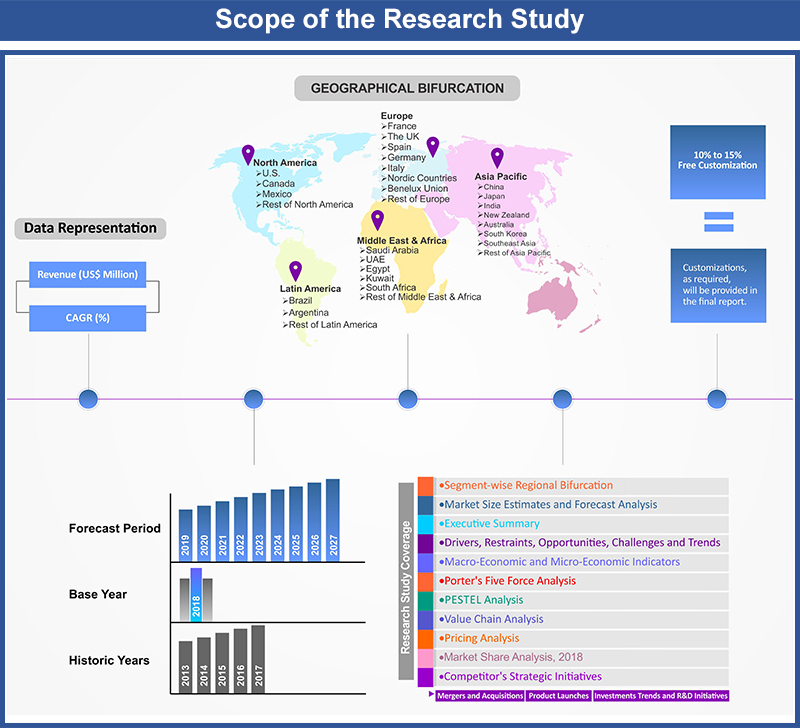Somatostatin Receptor Type 4 Market by Type (NTX-0290, NNC-26910, Veldoreotide), by Application (Chronic Pain, Acromegaly, Neuropathic Pain, Alzheimer’s Disease, Cognitive Disorder, Dementia, Diabetic Retinopathy, Gastrointestinal Tumor, Neuroendocrine Tumors, Pancreatic Tumor, Pituitary ACTH Hypersecretion); by Regional outlook (U.S., Rest of North America, France, UK, Germany, Spain, Italy, Rest of Europe, China, Japan, India, Southeast Asia, Rest of Asia Pacific, GCC Countries, Southern Africa, Rest of MEA, Brazil, Rest of Latin America) – Global Insights, Growth, Size, Comparative Analysis, Trends and Forecast, 2018 - 2026
Industry Trends
Somatostatin Receptor Type 4, encoded as SSTR4 in humans, is a gene on chromosome 20p11.2 that encodes a G protein-coupled somatostatin receptor for somatostatin-14. SSTR4 is specifically expressed in pituitary and pancreas in addition to the brain. It is responsible for mediating antiproliferative action of somatostatin in tumor cells. The advancement of sophisticated analytical techniques and isolation technologies is making extraction and application of SSTR4 possible for multiple diseases. Some of the diseases include acromegaly, gastrointestinal tumor, cognitive disorders, pancreatic tumor among others.
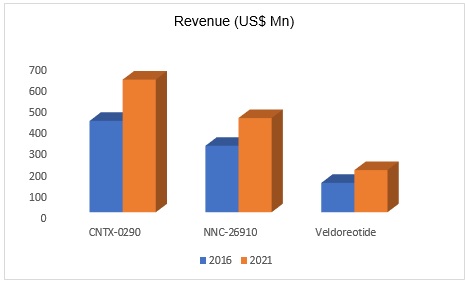
As somatostatin and its analogs are capable of varied actions, their potential in contribution to cancer diagnosis and treatment via multiple mechanisms is being explored. The inhibition of the hormonal hypersecretion often provides symptomatic relief and tumor shrinkage occurs in some patients. Hence, somatostatin is well-established in the treatment of pituitary tumors and neuroendocrine tumors of the pancreas and gastrointestinal tract. Owing to the demand for SSTR4 assays over numerous therapeutic areas, pharmaceutical companies are investing in research & development to explore the vast possibilities of somatostatin receptor type 4.
Somatostatin Receptor Type 4, By Application
The application of SSTR4 is anticipated to capture the highest market in chronic pain. The somatostatin receptor type 4 market by chronic pain was valued at US$ 193.5 Mn in 2016 expanding at a CAGR of 8.0 % from 2017 to 2025. The rise in cases of chronic pain is not specific but can stem from imbalanced sleep, fatigue, decreased appetite and mood changes. Somatostatin inhibits nociceptive combined with inflammatory processes via the SSTR4 pathway. Somatostatin alleviates pain even in cases when opioids fail and has an important role in neuromodulations such as pain control.
Somatostatin Receptor Type 4, By Region
North America exhibits an upper hand in consumption and demand of Somatostatin Receptor Type 4. Increasing incidences of lifestyle diseases in the region as well as affordability for treatment is propelling the market. The most common assays include cAMP assays, radioligand binding assays and metabolic stability assays. The availability of skilled technicians and workforce resulting from good education and training institutes is also aiding the growth of the somatostatin receptor type 4 market in the region.
Competitive Landscape
The report provides both, qualitative and quantitative research of the market, as well as integrates worthy insights into the rational scenario and favored development methods adopted by the key contenders. The report also offers extensive research on the key players in this market and detailed insights on the competitiveness of these players. The key business strategies such as mergers & acquisitions (M&A), affiliations, collaborations, and contracts adopted by the major players are also recognized and analyzed in the somatostatin receptor type 4 market report. For each company, the report recognizes their corporate headquarter, competitors, product/service type, application and specification, pricing, and gross margin.
Some of the primary market participants are Centrexion Therapeutics, CRINETICS PHARMACEUTICALS and Strongbridge Biopharma plc amongst others.
Global Somatostatin Receptor Type 4 Industry Background
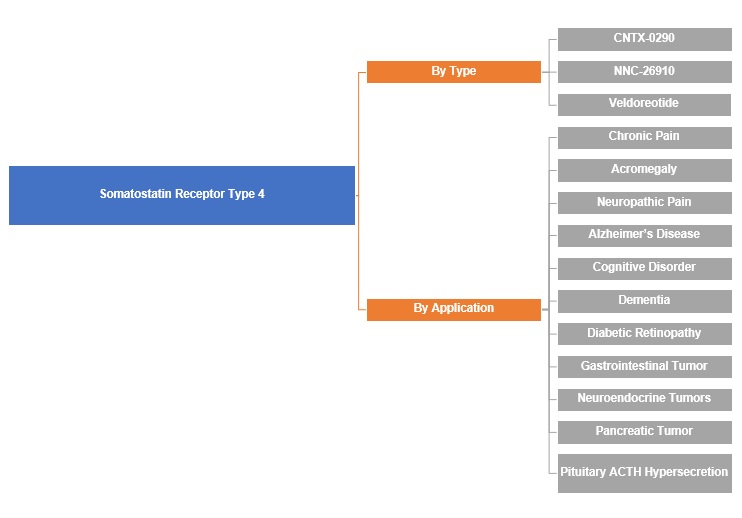
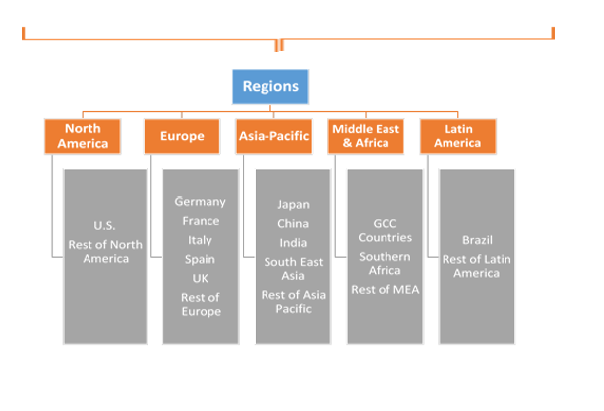
1. Introduction
1.1. Market Scope
1.2. Market Segmentation
1.3. Methodology
1.4. Assumptions
2. Somatostatin Receptor Type 4 Market Snapshot
3. Executive Summary: Somatostatin Receptor Type 4 Market
4. Qualitative Analysis: Somatostatin Receptor Type 4 Market
4.1. Introduction
4.1.1. Product Definition
4.1.2. Industry Development
4.2. Market Dynamics
4.2.1. Drivers
4.2.2. Restraints
4.2.3. Opportunities
4.3. Trends in Market
5. Global Somatostatin Receptor Type 4 Market Analysis and
Forecasts, 2018 – 2026
5.1. Overview
5.1.1. Global Market Revenue (US$ Mn) and Forecasts
5.2. Global Somatostatin Receptor Type 4 Market Revenue (US$ Mn)
and Forecasts, By Type
5.2.1. CNTX-0290
5.2.1.1. Definition
5.2.1.2. Market Penetration
5.2.1.3. Market Revenue Expected to Increase by 2026
5.2.1.4. Compound Annual Growth Rate (CAGR)
5.2.2. NNC-26910
5.2.2.1. Definition
5.2.2.2. Market Penetration
5.2.2.3. Market Revenue Expected to Increase by 2026
5.2.2.4. Compound Annual Growth Rate (CAGR)
5.2.3. Veldoreotide
5.2.3.1. Definition
5.2.3.2. Market Penetration
5.2.3.3. Market Revenue Expected to Increase by 2026
5.2.3.4. Compound Annual Growth Rate (CAGR)
5.3. Key Segment for Channeling Investments
5.3.1. By Type
6. Global Somatostatin Receptor Type 4 Market Analysis and
Forecasts, 2018 – 2026
6.1. Overview
6.2. Global Somatostatin Receptor Type 4 Market Revenue (US$ Mn)
and Forecasts, By Application
6.2.1. Chronic Pain
6.2.1.1. Definition
6.2.1.2. Market Penetration
6.2.1.3. Market Revenue Expected to Increase by 2026
6.2.1.4. Compound Annual Growth Rate (CAGR)
6.2.2. Acromegaly
6.2.2.1. Definition
6.2.2.2. Market Penetration
6.2.2.3. Market Revenue Expected to Increase by 2026
6.2.2.4. Compound Annual Growth Rate (CAGR)
6.2.3. Neuropathic Pain
6.2.3.1. Definition
6.2.3.2. Market Penetration
6.2.3.3. Market Revenue Expected to Increase by 2026
6.2.3.4. Compound Annual Growth Rate (CAGR)
6.2.4. Alzheimer’s Disease
6.2.4.1. Definition
6.2.4.2. Market Penetration
6.2.4.3. Market Revenue Expected to Increase by 2026
6.2.4.4. Compound Annual Growth Rate (CAGR)
6.2.5. Cognitive Disorder
6.2.5.1. Definition
6.2.5.2. Market Penetration
6.2.5.3. Market Revenue Expected to Increase by 2026
6.2.5.4. Compound Annual Growth Rate (CAGR)
6.2.6. Dementia
6.2.6.1. Definition
6.2.6.2. Market Penetration
6.2.6.3. Market Revenue Expected to Increase by 2026
6.2.6.4. Compound Annual Growth Rate (CAGR)
6.2.7. Diabetic Retinopathy
6.2.7.1. Definition
6.2.7.2. Market Penetration
6.2.7.3. Market Revenue Expected to Increase by 2026
6.2.7.4. Compound Annual Growth Rate (CAGR)
6.2.8. Gastrointestinal Tumor
6.2.8.1. Definition
6.2.8.2. Market Penetration
6.2.8.3. Market Revenue Expected to Increase by 2026
6.2.8.4. Compound Annual Growth Rate (CAGR)
6.2.9. Neuroendocrine Tumors
6.2.9.1. Definition
6.2.9.2. Market Penetration
6.2.9.3. Market Revenue Expected to Increase by 2026
6.2.9.4. Compound Annual Growth Rate (CAGR)
6.2.10. Pancreatic Tumor
6.2.10.1. Definition
6.2.10.2. Market Penetration
6.2.10.3. Market Revenue Expected to Increase by 2026
6.2.10.4. Compound Annual Growth Rate (CAGR)
6.2.11. Pituitary ACTH Hypersecretion
6.2.11.1. Definition
6.2.11.2. Market Penetration
6.2.11.3. Market Revenue Expected to Increase by 2026
6.2.11.4. Compound Annual Growth Rate (CAGR)
6.3. Key Segment for Channeling Investments
6.3.1. By Application
7. North America Somatostatin Receptor Type 4 Market Analysis
and Forecasts, 2018 – 2026
7.1. Overview
7.1.1. North America Market Revenue (US$ Mn)
7.2. North America Market Revenue (US$ Mn) and Forecasts, By Type
7.2.1. CNTX-0290
7.2.2. NNC-26910
7.2.3. Veldoreotide
7.3. North America Somatostatin Receptor Type 4 Market Revenue (US$
Mn) and Forecasts, By Application
7.3.1. Chronic Pain
7.3.2. Acromegaly
7.3.3. Neuropathic Pain
7.3.4. Alzheimer’s Disease
7.3.5. Cognitive Disorder
7.3.6. Dementia
7.3.7. Diabetic Retinopathy
7.3.8. Gastrointestinal Tumor
7.3.9. Neuroendocrine Tumors
7.3.10. Pancreatic Tumor
7.3.11. Pituitary ACTH Hypersecretion
7.4. North America Market Revenue (US$ Mn) and Forecasts, By
Country
7.4.1. U.S.
7.4.1.1. U.S. Somatostatin Receptor Type 4 Market Revenue (US$ Mn) and
Forecasts, By Type
7.4.1.1.1. CNTX-0290
7.4.1.1.2. NNC-26910
7.4.1.1.3. Veldoreotide
7.4.1.2. U.S. Somatostatin Receptor Type 4 Market Revenue (US$ Mn) and
Forecasts, By Application
7.4.1.2.1. Chronic Pain
7.4.1.2.2. Acromegaly
7.4.1.2.3. Neuropathic Pain
7.4.1.2.4. Alzheimer’s Disease
7.4.1.2.5. Cognitive Disorder
7.4.1.2.6. Dementia
7.4.1.2.7. Diabetic Retinopathy
7.4.1.2.8. Gastrointestinal Tumor
7.4.1.2.9. Neuroendocrine Tumors
7.4.1.2.10. Pancreatic Tumor
7.4.1.2.11. Pituitary ACTH Hypersecretion
7.4.2. Rest of North America
7.4.2.1. Rest of North America Somatostatin Receptor Type 4 Market
Revenue (US$ Mn) and Forecasts, By Type
7.4.2.1.1. CNTX-0290
7.4.2.1.2. NNC-26910
7.4.2.1.3. Veldoreotide
7.4.2.2. Rest of North America Somatostatin Receptor Type 4 Market
Revenue (US$ Mn) and Forecasts, By Application
7.4.2.2.1. Chronic Pain
7.4.2.2.2. Acromegaly
7.4.2.2.3. Neuropathic Pain
7.4.2.2.4. Alzheimer’s Disease
7.4.2.2.5. Cognitive Disorder
7.4.2.2.6. Dementia
7.4.2.2.7. Diabetic Retinopathy
7.4.2.2.8. Gastrointestinal Tumor
7.4.2.2.9. Neuroendocrine Tumors
7.4.2.2.10. Pancreatic Tumor
7.4.2.2.11. Pituitary ACTH Hypersecretion
7.5. Key Segment for Channeling Investments
7.5.1. By Country
7.5.2. By Type
7.5.3. By Application
8. Europe Somatostatin Receptor Type 4 Market Analysis and
Forecasts, 2018 – 2026
8.1. Overview
8.1.1. Europe Market Revenue (US$ Mn)
8.2. Europe Market Revenue (US$ Mn) and Forecasts, By Type
8.2.1. CNTX-0290
8.2.2. NNC-26910
8.2.3. Veldoreotide
8.3. Europe Somatostatin Receptor Type 4 Market Revenue (US$ Mn)
and Forecasts, By Application
8.3.1. Chronic Pain
8.3.2. Acromegaly
8.3.3. Neuropathic Pain
8.3.4. Alzheimer’s Disease
8.3.5. Cognitive Disorder
8.3.6. Dementia
8.3.7. Diabetic Retinopathy
8.3.8. Gastrointestinal Tumor
8.3.9. Neuroendocrine Tumors
8.3.10. Pancreatic Tumor
8.3.11. Pituitary ACTH Hypersecretion
8.4. Europe Somatostatin Receptor Type 4 Market Revenue (US$ Mn)
and Forecasts, By Country
8.4.1. France
8.4.1.1. France Somatostatin Receptor Type 4 Market Revenue (US$ Mn)
and Forecasts, By Type
8.4.1.1.1. CNTX-0290
8.4.1.1.2. NNC-26910
8.4.1.1.3. Veldoreotide
8.4.1.2. France Somatostatin Receptor Type 4 Market Revenue (US$ Mn)
and Forecasts, By Application
8.4.1.2.1. Chronic Pain
8.4.1.2.2. Acromegaly
8.4.1.2.3. Neuropathic Pain
8.4.1.2.4. Alzheimer’s Disease
8.4.1.2.5. Cognitive Disorder
8.4.1.2.6. Dementia
8.4.1.2.7. Diabetic Retinopathy
8.4.1.2.8. Gastrointestinal Tumor
8.4.1.2.9. Neuroendocrine Tumors
8.4.1.2.10. Pancreatic Tumor
8.4.1.2.11. Pituitary ACTH Hypersecretion
8.4.2. The UK
8.4.2.1. The UK Somatostatin Receptor Type 4 Market Revenue (US$ Mn)
and Forecasts, By Type
8.4.2.1.1. CNTX-0290
8.4.2.1.2. NNC-26910
8.4.2.1.3. Veldoreotide
8.4.2.2. The UK Somatostatin Receptor Type 4 Market Revenue (US$ Mn)
and Forecasts, By Application
8.4.2.2.1. Chronic Pain
8.4.2.2.2. Acromegaly
8.4.2.2.3. Neuropathic Pain
8.4.2.2.4. Alzheimer’s Disease
8.4.2.2.5. Cognitive Disorder
8.4.2.2.6. Dementia
8.4.2.2.7. Diabetic Retinopathy
8.4.2.2.8. Gastrointestinal Tumor
8.4.2.2.9. Neuroendocrine Tumors
8.4.2.2.10. Pancreatic Tumor
8.4.2.2.11. Pituitary ACTH Hypersecretion
8.4.3. Spain
8.4.3.1. Spain Somatostatin Receptor Type 4 Market Revenue (US$ Mn) and
Forecasts, By Type
8.4.3.1.1. CNTX-0290
8.4.3.1.2. NNC-26910
8.4.3.1.3. Veldoreotide
8.4.3.2. Spain Somatostatin Receptor Type 4 Market Revenue (US$ Mn) and
Forecasts, By Application
8.4.3.2.1. Chronic Pain
8.4.3.2.2. Acromegaly
8.4.3.2.3. Neuropathic Pain
8.4.3.2.4. Alzheimer’s Disease
8.4.3.2.5. Cognitive Disorder
8.4.3.2.6. Dementia
8.4.3.2.7. Diabetic Retinopathy
8.4.3.2.8. Gastrointestinal Tumor
8.4.3.2.9. Neuroendocrine Tumors
8.4.3.2.10. Pancreatic Tumor
8.4.3.2.11. Pituitary ACTH Hypersecretion
8.4.4. Germany
8.4.4.1. Germany Somatostatin Receptor Type 4 Market Revenue (US$ Mn)
and Forecasts, By Type
8.4.4.1.1. CNTX-0290
8.4.4.1.2. NNC-26910
8.4.4.1.3. Veldoreotide
8.4.4.2. Germany Somatostatin Receptor Type 4 Market Revenue (US$ Mn)
and Forecasts, By Application
8.4.4.2.1. Chronic Pain
8.4.4.2.2. Acromegaly
8.4.4.2.3. Neuropathic Pain
8.4.4.2.4. Alzheimer’s Disease
8.4.4.2.5. Cognitive Disorder
8.4.4.2.6. Dementia
8.4.4.2.7. Diabetic Retinopathy
8.4.4.2.8. Gastrointestinal Tumor
8.4.4.2.9. Neuroendocrine Tumors
8.4.4.2.10. Pancreatic Tumor
8.4.4.2.11. Pituitary ACTH Hypersecretion
8.4.5. Italy
8.4.5.1. Italy Somatostatin Receptor Type 4 Market Revenue (US$ Mn) and
Forecasts, By Type
8.4.5.1.1. CNTX-0290
8.4.5.1.2. NNC-26910
8.4.5.1.3. Veldoreotide
8.4.5.2. Italy Somatostatin Receptor Type 4 Market Revenue (US$ Mn) and
Forecasts, By Application
8.4.5.2.1. Chronic Pain
8.4.5.2.2. Acromegaly
8.4.5.2.3. Neuropathic Pain
8.4.5.2.4. Alzheimer’s Disease
8.4.5.2.5. Cognitive Disorder
8.4.5.2.6. Dementia
8.4.5.2.7. Diabetic Retinopathy
8.4.5.2.8. Gastrointestinal Tumor
8.4.5.2.9. Neuroendocrine Tumors
8.4.5.2.10. Pancreatic Tumor
8.4.5.2.11. Pituitary ACTH Hypersecretion
8.4.6. Rest of Europe
8.4.6.1. Rest of Europe Somatostatin Receptor Type 4 Market Revenue
(US$ Mn) and Forecasts, By Type
8.4.6.1.1. CNTX-0290
8.4.6.1.2. NNC-26910
8.4.6.1.3. Veldoreotide
8.4.6.2. Rest of Europe Somatostatin Receptor Type 4 Market Revenue
(US$ Mn) and Forecasts, By Application
8.4.6.2.1. Chronic Pain
8.4.6.2.2. Acromegaly
8.4.6.2.3. Neuropathic Pain
8.4.6.2.4. Alzheimer’s Disease
8.4.6.2.5. Cognitive Disorder
8.4.6.2.6. Dementia
8.4.6.2.7. Diabetic Retinopathy
8.4.6.2.8. Gastrointestinal Tumor
8.4.6.2.9. Neuroendocrine Tumors
8.4.6.2.10. Pancreatic Tumor
8.4.6.2.11. Pituitary ACTH Hypersecretion
8.5. Key Segment for Channeling Investments
8.5.1. By Country
8.5.2. By Type
8.5.3. By Application
9. Asia Pacific Somatostatin Receptor Type 4 Market Analysis and
Forecasts, 2018 – 2026
9.1. Overview
9.1.1. Asia Pacific Market Revenue (US$ Mn)
9.2. Asia Pacific Market Revenue (US$ Mn) and Forecasts, By Type
9.2.1. CNTX-0290
9.2.2. NNC-26910
9.2.3. Veldoreotide
9.3. Asia Pacific Somatostatin Receptor Type 4 Market Revenue (US$
Mn) and Forecasts, By Application
9.3.1. Chronic Pain
9.3.2. Acromegaly
9.3.3. Neuropathic Pain
9.3.4. Alzheimer’s Disease
9.3.5. Cognitive Disorder
9.3.6. Dementia
9.3.7. Diabetic Retinopathy
9.3.8. Gastrointestinal Tumor
9.3.9. Neuroendocrine Tumors
9.3.10. Pancreatic Tumor
9.3.11. Pituitary ACTH Hypersecretion
9.4. Asia Pacific Market Revenue (US$ Mn) and Forecasts, By Country
9.4.1. China
9.4.1.1. China Somatostatin Receptor Type 4 Market Revenue (US$ Mn) and
Forecasts, By Type
9.4.1.1.1. CNTX-0290
9.4.1.1.2. NNC-26910
9.4.1.1.3. Veldoreotide
9.4.1.2. China Somatostatin Receptor Type 4 Market Revenue (US$ Mn) and
Forecasts, By Application
9.4.1.2.1. Chronic Pain
9.4.1.2.2. Acromegaly
9.4.1.2.3. Neuropathic Pain
9.4.1.2.4. Alzheimer’s Disease
9.4.1.2.5. Cognitive Disorder
9.4.1.2.6. Dementia
9.4.1.2.7. Diabetic Retinopathy
9.4.1.2.8. Gastrointestinal Tumor
9.4.1.2.9. Neuroendocrine Tumors
9.4.1.2.10. Pancreatic Tumor
9.4.1.2.11. Pituitary ACTH Hypersecretion
9.4.2. Japan
9.4.2.1. Japan Somatostatin Receptor Type 4 Market Revenue (US$ Mn) and
Forecasts, By Type
9.4.2.1.1. CNTX-0290
9.4.2.1.2. NNC-26910
9.4.2.1.3. Veldoreotide
9.4.2.2. Japan Somatostatin Receptor Type 4 Market Revenue (US$ Mn) and
Forecasts, By Application
9.4.2.2.1. Chronic Pain
9.4.2.2.2. Acromegaly
9.4.2.2.3. Neuropathic Pain
9.4.2.2.4. Alzheimer’s Disease
9.4.2.2.5. Cognitive Disorder
9.4.2.2.6. Dementia
9.4.2.2.7. Diabetic Retinopathy
9.4.2.2.8. Gastrointestinal Tumor
9.4.2.2.9. Neuroendocrine Tumors
9.4.2.2.10. Pancreatic Tumor
9.4.2.2.11. Pituitary ACTH Hypersecretion
9.4.3. India
9.4.3.1. India Somatostatin Receptor Type 4 Market Revenue (US$ Mn) and
Forecasts, By Type
9.4.3.1.1. CNTX-0290
9.4.3.1.2. NNC-26910
9.4.3.1.3. Veldoreotide
9.4.3.2. India Somatostatin Receptor Type 4 Market Revenue (US$ Mn) and
Forecasts, By Application
9.4.3.2.1. Chronic Pain
9.4.3.2.2. Acromegaly
9.4.3.2.3. Neuropathic Pain
9.4.3.2.4. Alzheimer’s Disease
9.4.3.2.5. Cognitive Disorder
9.4.3.2.6. Dementia
9.4.3.2.7. Diabetic Retinopathy
9.4.3.2.8. Gastrointestinal Tumor
9.4.3.2.9. Neuroendocrine Tumors
9.4.3.2.10. Pancreatic Tumor
9.4.3.2.11. Pituitary ACTH Hypersecretion
9.4.4. Southeast Asia
9.4.4.1. Southeast Asia Somatostatin Receptor Type 4 Market Revenue
(US$ Mn) and Forecasts, By Type
9.4.4.1.1. CNTX-0290
9.4.4.1.2. NNC-26910
9.4.4.1.3. Veldoreotide
9.4.4.2. Southeast Asia Somatostatin Receptor Type 4 Market Revenue
(US$ Mn) and Forecasts, By Application
9.4.4.2.1. Chronic Pain
9.4.4.2.2. Acromegaly
9.4.4.2.3. Neuropathic Pain
9.4.4.2.4. Alzheimer’s Disease
9.4.4.2.5. Cognitive Disorder
9.4.4.2.6. Dementia
9.4.4.2.7. Diabetic Retinopathy
9.4.4.2.8. Gastrointestinal Tumor
9.4.4.2.9. Neuroendocrine Tumors
9.4.4.2.10. Pancreatic Tumor
9.4.4.2.11. Pituitary ACTH Hypersecretion
9.4.5. Rest of Asia Pacific
9.4.5.1. Rest of Asia Pacific Somatostatin Receptor Type 4 Market
Revenue (US$ Mn) and Forecasts, By Type
9.4.5.1.1. CNTX-0290
9.4.5.1.2. NNC-26910
9.4.5.1.3. Veldoreotide
9.4.5.2. Rest of Asia Pacific Somatostatin Receptor Type 4 Market
Revenue (US$ Mn) and Forecasts, By Application
9.4.5.2.1. Chronic Pain
9.4.5.2.2. Acromegaly
9.4.5.2.3. Neuropathic Pain
9.4.5.2.4. Alzheimer’s Disease
9.4.5.2.5. Cognitive Disorder
9.4.5.2.6. Dementia
9.4.5.2.7. Diabetic Retinopathy
9.4.5.2.8. Gastrointestinal Tumor
9.4.5.2.9. Neuroendocrine Tumors
9.4.5.2.10. Pancreatic Tumor
9.4.5.2.11. Pituitary ACTH Hypersecretion
9.5. Key Segment for Channeling Investments
9.5.1. By Country
9.5.2. By Type
9.5.3. By Application
10. Middle East and Africa Somatostatin Receptor Type 4 Market Analysis
and Forecasts, 2018 – 2026
10.1. Overview
10.1.1. Middle East and Africa Market Revenue (US$ Mn)
10.2. Middle East and Africa Market Revenue (US$ Mn) and Forecasts,
By Type
10.2.1. CNTX-0290
10.2.2. NNC-26910
10.2.3. Veldoreotide
10.3. Middle East and Africa Somatostatin Receptor Type 4 Market Revenue
(US$ Mn) and Forecasts, By Application
10.3.1. Chronic Pain
10.3.2. Acromegaly
10.3.3. Neuropathic Pain
10.3.4. Alzheimer’s Disease
10.3.5. Cognitive Disorder
10.3.6. Dementia
10.3.7. Diabetic Retinopathy
10.3.8. Gastrointestinal Tumor
10.3.9. Neuroendocrine Tumors
10.3.10. Pancreatic Tumor
10.3.11. Pituitary ACTH Hypersecretion
10.4. Middle East and Africa Somatostatin Receptor Type 4 Market
Revenue (US$ Mn) and Forecasts, By Country
10.4.1. GCC Countries
10.4.1.1. GCC Countries Somatostatin Receptor Type 4 Market Revenue (US$
Mn) and Forecasts, By Type
10.4.1.1.1. CNTX-0290
10.4.1.1.2. NNC-26910
10.4.1.1.3. Veldoreotide
10.4.1.2. GCC Countries Somatostatin Receptor Type 4 Market Revenue (US$
Mn) and Forecasts, By Application
10.4.1.2.1. Chronic Pain
10.4.1.2.2. Acromegaly
10.4.1.2.3. Neuropathic Pain
10.4.1.2.4. Alzheimer’s Disease
10.4.1.2.5. Cognitive Disorder
10.4.1.2.6. Dementia
10.4.1.2.7. Diabetic Retinopathy
10.4.1.2.8. Gastrointestinal Tumor
10.4.1.2.9. Neuroendocrine Tumors
10.4.1.2.10. Pancreatic Tumor
10.4.1.2.11. Pituitary ACTH Hypersecretion
10.4.2. Southern Africa
10.4.2.1. Southern Africa Somatostatin Receptor Type 4 Market Revenue
(US$ Mn) and Forecasts, By Type
10.4.2.1.1. CNTX-0290
10.4.2.1.2. NNC-26910
10.4.2.1.3. Veldoreotide
10.4.2.2. Southern Africa Somatostatin Receptor Type 4 Market Revenue
(US$ Mn) and Forecasts, By Application
10.4.2.2.1. Chronic Pain
10.4.2.2.2. Acromegaly
10.4.2.2.3. Neuropathic Pain
10.4.2.2.4. Alzheimer’s Disease
10.4.2.2.5. Cognitive Disorder
10.4.2.2.6. Dementia
10.4.2.2.7. Diabetic Retinopathy
10.4.2.2.8. Gastrointestinal Tumor
10.4.2.2.9. Neuroendocrine Tumors
10.4.2.2.10. Pancreatic Tumor
10.4.2.2.11. Pituitary ACTH Hypersecretion
10.4.3. Rest of MEA
10.4.3.1. Rest of MEA Somatostatin Receptor Type 4 Market Revenue (US$
Mn) and Forecasts, By Type
10.4.3.1.1. CNTX-0290
10.4.3.1.2. NNC-26910
10.4.3.1.3. Veldoreotide
10.4.3.2. Rest of MEA Somatostatin Receptor Type 4 Market Revenue (US$
Mn) and Forecasts, By Application
10.4.3.2.1. Chronic Pain
10.4.3.2.2. Acromegaly
10.4.3.2.3. Neuropathic Pain
10.4.3.2.4. Alzheimer’s Disease
10.4.3.2.5. Cognitive Disorder
10.4.3.2.6. Dementia
10.4.3.2.7. Diabetic Retinopathy
10.4.3.2.8. Gastrointestinal Tumor
10.4.3.2.9. Neuroendocrine Tumors
10.4.3.2.10. Pancreatic Tumor
10.4.3.2.11. Pituitary ACTH Hypersecretion
10.5. Key Segment for Channeling Investments
10.5.1. By Country
10.5.2. By Type
10.5.3. By Application
11. Latin America Somatostatin Receptor Type 4 Market Analysis
and Forecasts, 2018 – 2026
11.1. Overview
11.1.1. Latin America Market Revenue (US$ Mn)
11.2. Latin America Market Revenue (US$ Mn) and Forecasts, By Type
11.2.1. CNTX-0290
11.2.2. NNC-26910
11.2.3. Veldoreotide
11.3. Latin America Somatostatin Receptor Type 4 Market Revenue (US$
Mn) and Forecasts, By Application
11.3.1. Chronic Pain
11.3.2. Acromegaly
11.3.3. Neuropathic Pain
11.3.4. Alzheimer’s Disease
11.3.5. Cognitive Disorder
11.3.6. Dementia
11.3.7. Diabetic Retinopathy
11.3.8. Gastrointestinal Tumor
11.3.9. Neuroendocrine Tumors
11.3.10. Pancreatic Tumor
11.3.11. Pituitary ACTH Hypersecretion
11.4. Latin America Somatostatin Receptor Type 4 Market Revenue (US$
Mn) and Forecasts, By Country
11.4.1. Brazil
11.4.1.1. Brazil Somatostatin Receptor Type 4 Market Revenue (US$ Mn)
and Forecasts, By Type
11.4.1.1.1. CNTX-0290
11.4.1.1.2. NNC-26910
11.4.1.1.3. Veldoreotide
11.4.1.2. Brazil Somatostatin Receptor Type 4 Market Revenue (US$ Mn)
and Forecasts, By Application
11.4.1.2.1. Chronic Pain
11.4.1.2.2. Acromegaly
11.4.1.2.3. Neuropathic Pain
11.4.1.2.4. Alzheimer’s Disease
11.4.1.2.5. Cognitive Disorder
11.4.1.2.6. Dementia
11.4.1.2.7. Diabetic Retinopathy
11.4.1.2.8. Gastrointestinal Tumor
11.4.1.2.9. Neuroendocrine Tumors
11.4.1.2.10.
Pancreatic Tumor
11.4.1.2.11. Pituitary ACTH Hypersecretion
11.4.2. Rest of Latin America
11.4.2.1. Rest of Latin America Somatostatin Receptor Type 4 Market
Revenue (US$ Mn) and Forecasts, By Type
11.4.2.1.1. CNTX-0290
11.4.2.1.2. NNC-26910
11.4.2.1.3. Veldoreotide
11.4.2.2. Rest of Latin America Somatostatin Receptor Type 4 Market
Revenue (US$ Mn) and Forecasts, By Application
11.4.2.2.1. Chronic Pain
11.4.2.2.2. Acromegaly
11.4.2.2.3. Neuropathic Pain
11.4.2.2.4. Alzheimer’s Disease
11.4.2.2.5. Cognitive Disorder
11.4.2.2.6. Dementia
11.4.2.2.7. Diabetic Retinopathy
11.4.2.2.8. Gastrointestinal Tumor
11.4.2.2.9. Neuroendocrine Tumors
11.4.2.2.10. Pancreatic Tumor
11.4.2.2.11. Pituitary ACTH Hypersecretion
11.5. Key Segment for Channeling Investments
11.5.1. By Country
11.5.2. By Type
11.5.3. By Application
12. Competitive Benchmarking
12.1. Player Positioning Analysis
12.2. Global Presence and Growth Strategies
13. Player Profiles
13.1. Centrexion Therapeutics
13.1.1. Company Details
13.1.2. Company Overview
13.1.3. Product Offerings
13.1.4. Key Developments
13.1.5. Financial Analysis
13.1.6. SWOT Analysis
13.1.7. Business Strategies
13.2. CRINETICS PHARMACEUTICALS
13.2.1. Company Details
13.2.2. Company Overview
13.2.3. Product Offerings
13.2.4. Key Developments
13.2.5. Financial Analysis
13.2.6. SWOT Analysis
13.2.7. Business Strategies
13.3. Strongbridge Biopharma plc
13.3.1. Company Details
13.3.2. Company Overview
13.3.3. Product Offerings
13.3.4. Key Developments
13.3.5. Financial Analysis
13.3.6. SWOT Analysis
13.3.7. Business Strategies
Note:
This ToC is tentative and can be changed according to the research study
conducted during the course of report completion.
At Absolute Markets Insights, we are engaged in building both global as well as country specific reports. As a result, the approach taken for deriving the estimation and forecast for a specific country is a bit unique and different in comparison to the global research studies. In this case, we not only study the concerned market factors & trends prevailing in a particular country (from secondary research) but we also tend to calculate the actual market size & forecast from the revenue generated from the market participants involved in manufacturing or distributing the any concerned product. These companies can also be service providers. For analyzing any country specifically, we do consider the growth factors prevailing under the states/cities/county for the same. For instance, if we are analyzing an industry specific to United States, we primarily need to study about the states present under the same(where the product/service has the highest growth). Similar analysis will be followed by other countries. Our scope of the report changes with different markets.
Our research study is mainly implement through a mix of both secondary and primary research. Various sources such as industry magazines, trade journals, and government websites and trade associations are reviewed for gathering precise data. Primary interviews are conducted to validate the market size derived from secondary research. Industry experts, major manufacturers and distributors are contacted for further validation purpose on the current market penetration and growth trends.
Prominent participants in our primary research process include:
- Key Opinion Leaders namely the CEOs, CSOs, VPs, purchasing managers, amongst others
- Research and development participants, distributors/suppliers and subject matter experts
Secondary Research includes data extracted from paid data sources:
- Reuters
- Factiva
- Bloomberg
- One Source
- Hoovers
Research Methodology
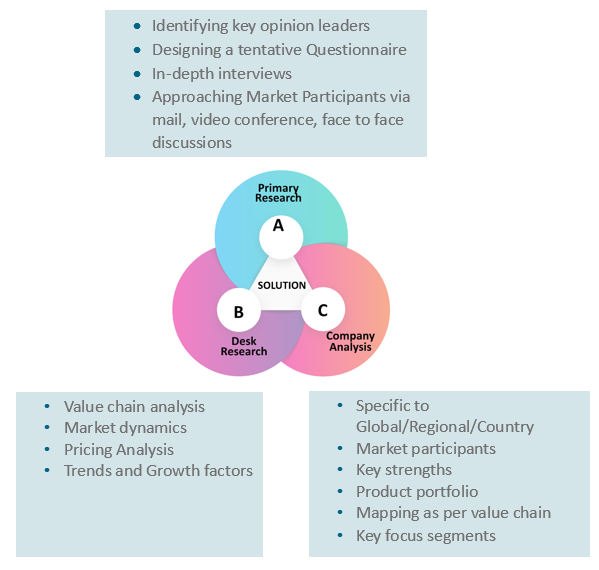
Key Inclusions
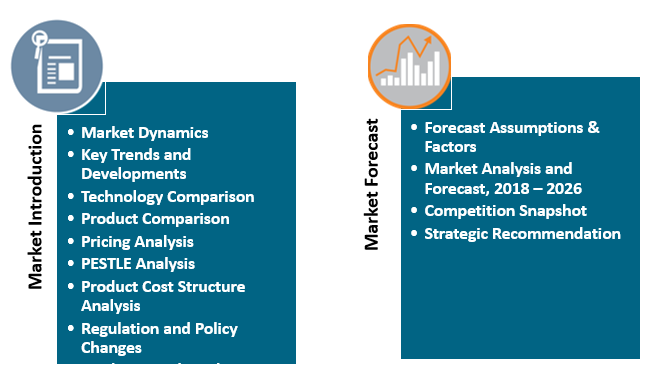
Reach to us
Call us on
+91-74002-42424
Drop us an email at
sales@absolutemarketsinsights.com
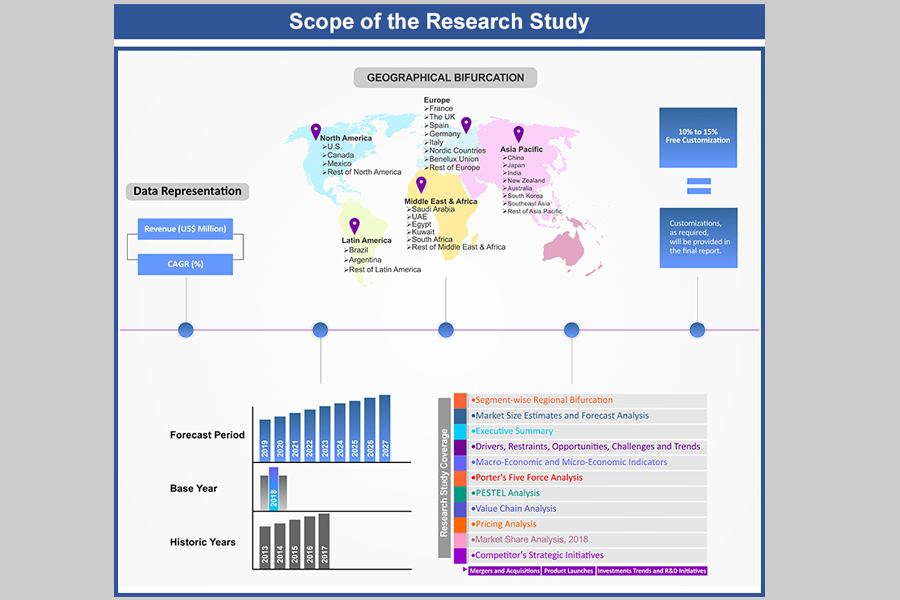
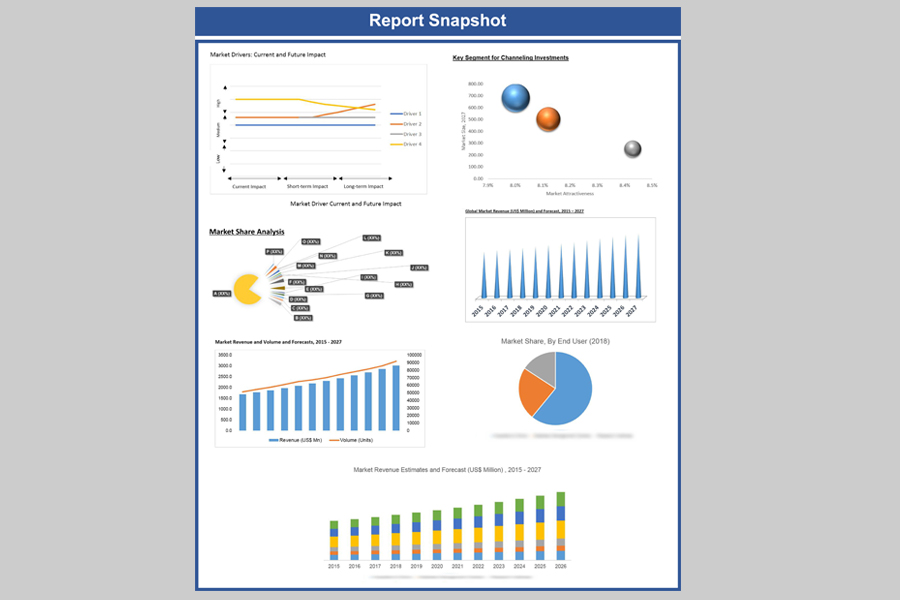
Why Absolute Markets Insights?
An effective strategy is the entity that influences a business to stand out of the crowd. An organization with a phenomenal strategy for success dependably has the edge over the rivals in the market. It offers the organizations a head start in planning their strategy. Absolute Market Insights is the new initiation in the industry that will furnish you with the lead your business needs. Absolute Market Insights is the best destination for your business intelligence and analytical solutions; essentially because our qualitative and quantitative sources of information are competent to give one-stop solutions. We inventively combine qualitative and quantitative research in accurate proportions to have the best report, which not only gives the most recent insights but also assists you to grow.


